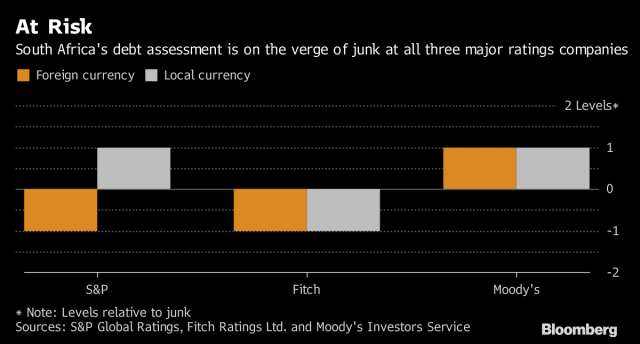While South African consumers are expected to make the 24th of November one of the biggest sale days on the calendar, the burst of economic activity will likely be marred by ratings downgrades to junk status.
Ratings agencies Moody’s and S&P Global are expected to announce the outcomes of their South African ratings reviews on 24 November, where many economists and analysts forecast full junk ratings.
Of the three major ratings agencies, Fitch is currently the only one that has the country in full junk status – where both local and foreign currency debt is rated as sub-investment grade.
S&P has South Africa’s foreign currency debt as junk, with local currency debt one notch above. Moody’s, meanwhile, has both local and foreign currency debt one notch above junk.
The distinction is important, as the majority of South Africa’s debt is held in local currency, meaning at current levels, the country is still holding on. If South Africa is forced into full junk status, this will have a hugely detrimental impact on the economy.
Aside from borrowing costs rising, and the rand taking a knock, full junk status will force South Africa out of the World Government Bond Index.
Investors and hedge funds are bound by policy to avoid countries which are not part of the World Government Bond Index (WGBI), and conservative estimates point to an immediate disinvestment of R100 billion by foreign investors. Some analysts say the outflow could go over R200 billion.
According to economists like Dawie Roodt, and firms like Anchor Capital, the question of full junk status is not on of “if”, but rather “when” – with many experts saying it is an inevitabile at this stage.
Fund manager at Ashburton Investments, Wayne McCurrie said that this Friday is most likely going to be D-day for at least one of the two holdout firms.
“S&P will most likely downgrade domestic debt to junk, and Moody’s will put us on negative watch for a imminent downgrade to junk,” he said. However he did not rule out that Moody’s would also plunge the country into full junk.
Reports this month said that Moody’s had ‘secret’ meetings in South Africa ahead of the 24 November review, sparking speculation that downgrades were imminent.
The ratings agencies have consistently warned about South Africa’s path to junk, highlighting:
- Domestic political uncertainty and social tensions, which weaken the commitment to economic and fiscal reform;
- High public debt levels – leaving little space to respond to shocks;
- The potential for destabilizing political events remains – particularly the ANC’s elective conference;
- High levels of unemployment;
- Low growth;
- Unchecked government spending, particularly related to state-owned companies – in terms of guarantees and bailouts;
- Threats to the independence of the Reserve Bank.
With South Africa heading to full junk, the expectation is that that rates will gravitate towards 10.25% and the rand towards R15.00 to the dollar at some point over the next year.
















